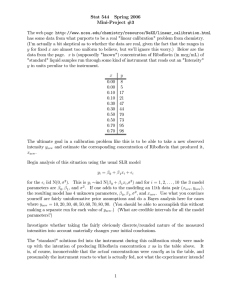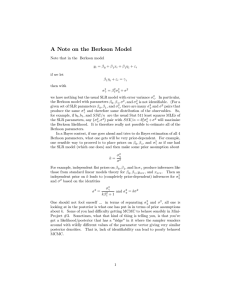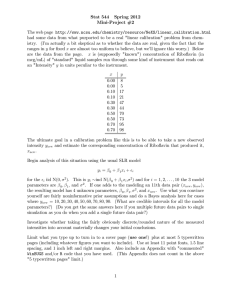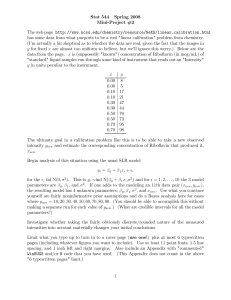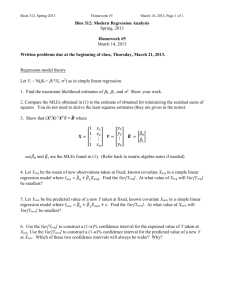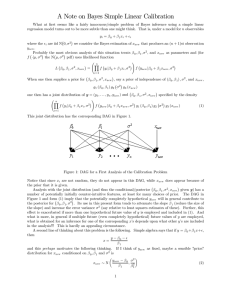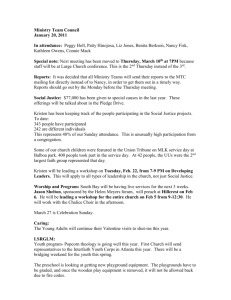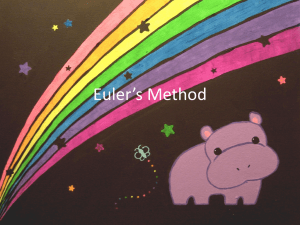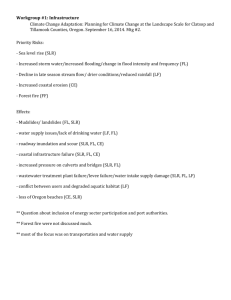Stat 544 Spring 2007 Mini-Project #3 The web page
advertisement
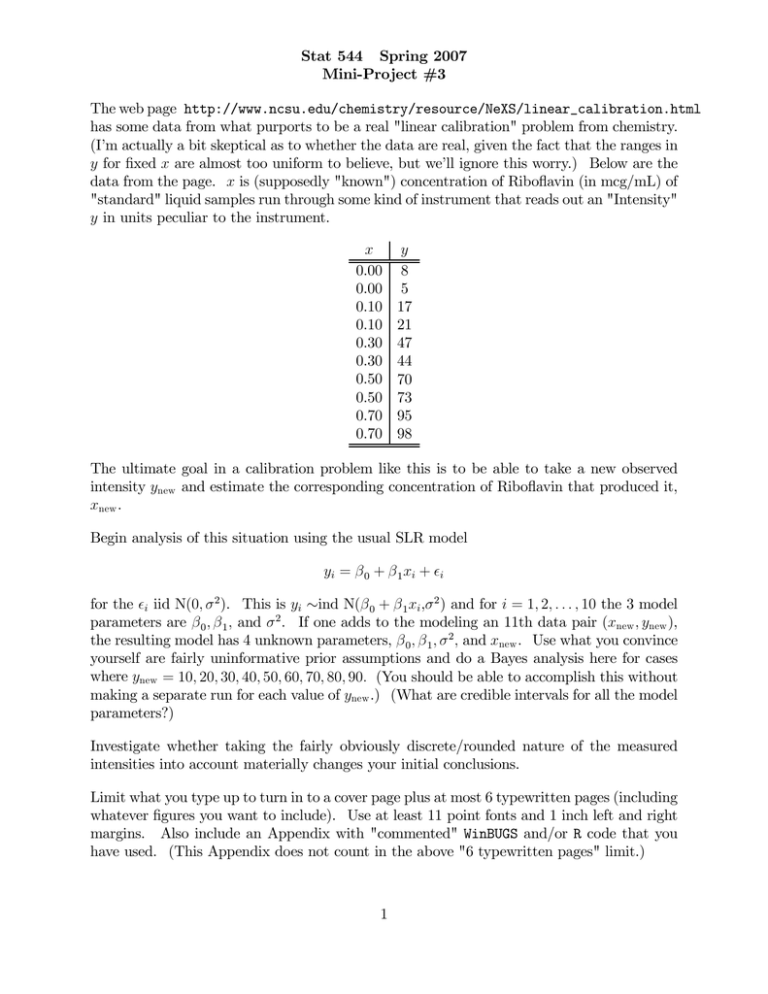
Stat 544 Spring 2007 Mini-Project #3 The web page http://www.ncsu.edu/chemistry/resource/NeXS/linear_calibration.html has some data from what purports to be a real "linear calibration" problem from chemistry. (I’m actually a bit skeptical as to whether the data are real, given the fact that the ranges in y for fixed x are almost too uniform to believe, but we’ll ignore this worry.) Below are the data from the page. x is (supposedly "known") concentration of Riboflavin (in mcg/mL) of "standard" liquid samples run through some kind of instrument that reads out an "Intensity" y in units peculiar to the instrument. x 0.00 0.00 0.10 0.10 0.30 0.30 0.50 0.50 0.70 0.70 y 8 5 17 21 47 44 70 73 95 98 The ultimate goal in a calibration problem like this is to be able to take a new observed intensity ynew and estimate the corresponding concentration of Riboflavin that produced it, xnew . Begin analysis of this situation using the usual SLR model yi = β 0 + β 1 xi + i for the i iid N(0, σ 2 ). This is yi ∼ind N(β 0 + β 1 xi ,σ 2 ) and for i = 1, 2, . . . , 10 the 3 model parameters are β 0 , β 1 , and σ 2 . If one adds to the modeling an 11th data pair (xnew , ynew ), the resulting model has 4 unknown parameters, β 0 , β 1 , σ 2 , and xnew . Use what you convince yourself are fairly uninformative prior assumptions and do a Bayes analysis here for cases where ynew = 10, 20, 30, 40, 50, 60, 70, 80, 90. (You should be able to accomplish this without making a separate run for each value of ynew .) (What are credible intervals for all the model parameters?) Investigate whether taking the fairly obviously discrete/rounded nature of the measured intensities into account materially changes your initial conclusions. Limit what you type up to turn in to a cover page plus at most 6 typewritten pages (including whatever figures you want to include). Use at least 11 point fonts and 1 inch left and right margins. Also include an Appendix with "commented" WinBUGS and/or R code that you have used. (This Appendix does not count in the above "6 typewritten pages" limit.) 1 A Note on the Berkson Model, Identifiability, and Bayes Analysis for This Problem The "standard" solutions fed into the instrument during this calibration study were made up with the intention of producing Riboflavin concentration x as in the table above. It is, of course, inconceivable that the actual concentrations were exactly as in the table, and presumably the instrument reacts to what is actually fed, not what the experimenter intends! Berkson’s famous analysis of the situation is then as follows. Suppose that the actual concentration produced in standard solution i is x0i = xi + η i ¡ ¢ where the η i are iid N 0, σ 2η independent of the observed intensity is then describable as yi = β 0 + β 1 x0i + i i (that remain as above), and that the = β 0 + β 1 xi + β 1 η i + i This model for the 10 pairs (xi , yi ) has 4 model parameters β 0 , β 1 , σ 2η , and σ 2 , and if an 11th data pair (xnew , ynew ) is included, there are 5 parameters. Investigate what is possible for a Bayes analysis here. (Note the attached discussion regarding Berkson’s model.)Note that in the Berkson model yi = β 0 + β 1 xi + β 1 η i + εi if we let β 1 η i + εi = γ i then with σ 2γ = β 21 σ 2η + σ 2 we have nothing but the usual SLR model with error variance σ 2γ . In particular, the Berkson model with parameters β 0 , β 1 , σ 2 , and σ 2η is not identifiable. (See Section 3.3.1 of the course outline. For a given set of SLR parameters β 0 , β 1 , and σ 2γ , there are many σ 2η and σ 2 pairs that produce the same σ 2γ and therefore same distribution of the observables. So, for example, if b¡0 , b1 , and Stat 511 least squares MLEs of the SLR ¢ SSE/n are the usual 2 2 2 2 parameters, any σ η , σ pair with SSE/n = b1 σ η +σ 2 will maximize the Berkson likelihood. It is therefore really not possible to estimate all of the Berkson parameters.) If tries to do Bayes estimation of all 4 Berkson parameters, what one gets will be very priordependent. For example, one seemingly sensible way to proceed is to place priors on β 0 , β 1 , and σ 2γ as if one had the SLR model (which one does) and then make some prior assumption about σ 2η k= 2 σ For example, independent flat priors on β 0 , β 1 , and ln σ γ produce inferences like those from standard linear models theory for β 0 , β 1 , ynew , and xnew . Then an independent prior on k leads to (completely prior-dependent) inferences for σ 2η and σ 2 based on the identities 2 σ = σ 2γ kβ 21 +1 and σ 2η = kσ 2 2 But one should not fool oneself ... in terms of separating σ 2η and σ 2 , all one is looking at in the posterior is what one has put in in terms of prior assumptions about k. Some sets of Bayes assumptions here may lead to seemingly bizarre behavior of MCMC simulations. Sometimes, what that kind of thing is telling you is that you’ve got a likelihood/posterior that has a "ridge" in it where the sampler wanders around with wildly different values of the parameter vector giving very similar posterior densities. That is, lack of identifiability can lead to poorly behaved MCMC. 3
